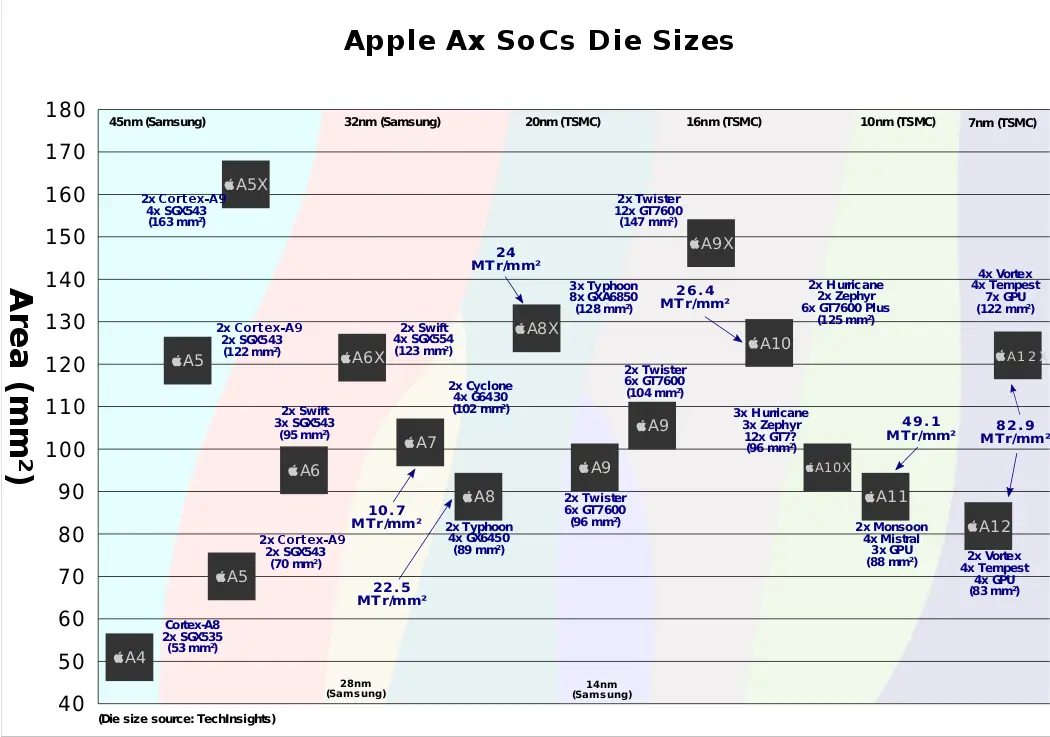From WikiChip
Difference between revisions of "apple/ax"
(→Members) |
|||
| (28 intermediate revisions by 16 users not shown) | |||
| Line 26: | Line 26: | ||
| proc 6 = 14 nm | | proc 6 = 14 nm | ||
| proc 7 = 10 nm | | proc 7 = 10 nm | ||
| + | | proc 8 = 7 nm | ||
| + | | proc 9 = 5 nm | ||
| tech = CMOS | | tech = CMOS | ||
| − | | clock min = | + | | clock min = 800 MHz |
| − | | clock max = | + | | clock max = 3.1 GHz |
| package = | | package = | ||
| socket = | | socket = | ||
| Line 41: | Line 43: | ||
== Overview == | == Overview == | ||
| − | Since the introduction of the original iPhone in [[2007]], Apple has been developing a series of chips designed exclusively for their own consumer products. Those system on chips are found in all iPhones, | + | Since the introduction of the original iPhone in [[2007]], Apple has been developing a series of chips designed exclusively for their own consumer products. Those system on chips are found in all iPhones, iPod Touches, iPads, Apple TVs, and Apple Watches. While initial models used [[IP cores]] licensed from [[ARM Holdings]], since the introduction of the {{\|A6}} in 2012, Apple has been developing their own [[microarchitecture]] for their chips which have become considerably more powerful than other [[ARM]]-based [[microprocessors]]. |
| + | |||
| + | === Analysis === | ||
| + | ==== Die size comparison ==== | ||
| + | <div style="width: 100%; text-align: center;">[[File:apple ax.svg|1050px]]</div> | ||
== Members == | == Members == | ||
| − | {{ | + | {{collist |
| + | | count = 3 | ||
| + | | | ||
| + | * {{\|A4}} | ||
| + | * {{\|A5}} | ||
| + | * {{\|A6}} | ||
| + | * {{\|A7}} | ||
| + | * {{\|A8}} | ||
| + | * {{\|A9}} | ||
| + | * {{\|A10}} | ||
| + | * {{\|A11}} | ||
| + | * {{\|A12}} | ||
| + | * {{\|A13}} | ||
| + | * {{\|A14}} | ||
| + | * {{\|A15}} | ||
| + | }} | ||
== See also == | == See also == | ||
| − | * Qualcomm | + | * Qualcomm {{qualcomm|Snapdragon}} |
| − | * Intel | + | * MediaTek {{mediatek|Helio}} |
| + | * Intel {{intel|Atom}} | ||
| + | |||
| + | <!-- nop 2 --> | ||
Latest revision as of 04:56, 10 May 2022
| Apple Ax | |
| Developer | Apple, ARM Holdings |
| Manufacturer | Samsung, TSMC |
| Type | System on Chips |
| Architecture | High-performance ARM SoCs |
| ISA | ARM |
| Word size | 32 bit 4 octets , 64 bit8 nibbles 8 octets
16 nibbles |
| Process | 45 nm 0.045 μm , 32 nm4.5e-5 mm 0.032 μm , 28 nm3.2e-5 mm 0.028 μm , 20 nm2.8e-5 mm 0.02 μm , 16 nm2.0e-5 mm 0.016 μm , 14 nm1.6e-5 mm 0.014 μm , 10 nm1.4e-5 mm 0.01 μm , 7 nm1.0e-5 mm 0.007 μm , 5 nm7.0e-6 mm 0.005 μm
5.0e-6 mm |
| Technology | CMOS |
| Clock | 800 MHz-3.1 GHz |
Ax is a family of high-performance 32-bit and 64-bit ARM system on chips designed by Apple exclusively for their consumer products.
Overview[edit]
Since the introduction of the original iPhone in 2007, Apple has been developing a series of chips designed exclusively for their own consumer products. Those system on chips are found in all iPhones, iPod Touches, iPads, Apple TVs, and Apple Watches. While initial models used IP cores licensed from ARM Holdings, since the introduction of the A6 in 2012, Apple has been developing their own microarchitecture for their chips which have become considerably more powerful than other ARM-based microprocessors.
Analysis[edit]
Die size comparison[edit]
Members[edit]
See also[edit]
- Qualcomm Snapdragon
- MediaTek Helio
- Intel Atom
Facts about "Ax - Apple"
| designer | Apple + and ARM Holdings + |
| full page name | apple/ax + |
| instance of | system on a chip family + |
| instruction set architecture | ARM + |
| main designer | Apple + |
| manufacturer | Samsung + and TSMC + |
| name | Apple Ax + |
| process | 45 nm (0.045 μm, 4.5e-5 mm) +, 32 nm (0.032 μm, 3.2e-5 mm) +, 28 nm (0.028 μm, 2.8e-5 mm) +, 20 nm (0.02 μm, 2.0e-5 mm) +, 16 nm (0.016 μm, 1.6e-5 mm) +, 14 nm (0.014 μm, 1.4e-5 mm) +, 10 nm (0.01 μm, 1.0e-5 mm) +, 7 nm (0.007 μm, 7.0e-6 mm) + and 5 nm (0.005 μm, 5.0e-6 mm) + |
| technology | CMOS + |
| word size | 32 bit (4 octets, 8 nibbles) + and 64 bit (8 octets, 16 nibbles) + |
